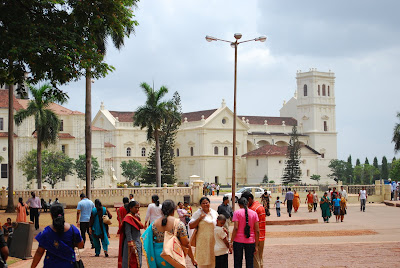 I have just returned from a week’s holiday on the palm fringed beaches of Goa. To anyone planning to go at this time of year, a word of warning - May to October is low season. The ubiquitous beach hut restaurants pack up in June and their licences prevent a return until October. This is because the monsoon season is approaching, when the rain lashes the coconut trees, floods the paddy fields and keeps all but Indian tourists at bay. Thankfully we managed to get to Majorda Beach as the rains were approaching Kerala to the south, and the beach shacks celebrated their last week of the season.
I have just returned from a week’s holiday on the palm fringed beaches of Goa. To anyone planning to go at this time of year, a word of warning - May to October is low season. The ubiquitous beach hut restaurants pack up in June and their licences prevent a return until October. This is because the monsoon season is approaching, when the rain lashes the coconut trees, floods the paddy fields and keeps all but Indian tourists at bay. Thankfully we managed to get to Majorda Beach as the rains were approaching Kerala to the south, and the beach shacks celebrated their last week of the season. Goa’s beaches are a different beast without their huts, and in Majorda, south of state capital of Panjim, we walked on wide expanses of clean, white sand dotted with three remaining places to eat. On our first day sheltering in the shade of the “Vodaphone hut” – a shack with oh so subtle advertising - we lingered over glass of the freshly made national soft drink nimboo pani. Made from the juice of fresh Indian lemons (which look like yellow limes) with water or soda, it is served sweet or salty depending on your tastes. Unable to face moving in the midday heat, our refreshments turned into lunch as we watched the local water buffalo cool off in the estuary, wishing we could do the same.
Lunch was Goan Chicken Xacuti – the only local dish on the menu, but this curry made with white poppy seeds and coconut gave us enough energy to eventually take a lazy walk back to our little guest house in the village. Being “off season” many of the local restaurants were firmly closed, so most evenings we ate at our residence. Settled on the veranda of the restored traditional Goan house, we often ate a menu of Western meals as was the taste of the British owners. Sitting in an evening of tropical humidity eating steak and mashed potato was a strange experience – especially as it was our first taste of beef in more than 3 months – and I was hoping to experience the local Goan food.
As a consequence of the long history of tourism, most of the restaurants we tried in Goa served every cuisine going except its own. Alongside the Chinese, North Indian, English and Mexican dishes, the most local thing available was the seafood. Anyone who has been to this tiny state, dreamily recalls the fresh prawns, king fish, pomfret and lobster they have eaten for just a few rupees. We devoured more than our fair share of king and tiger prawns simply served in butter and garlic, Portuguese Piri Piri sauce or Recheiado (a red masala spices including dried red chillies and black pepper in vinegar) but I continued my search for something even more authentic.
Keen to explore the region, we hired a driver for the day to visit the churches of Old Goa and the state capital Panjim (Panaji). After admiring the beautiful Churches and remains of the Portuguese reign we drove along the river to the capital for lunch.
Recommended by my Indian foodie Guru – we arrived at Mums Kitchen gasping for air conditioning and some authentic Goan Food. Their misson is “A move to save Goan Cuisine” and they are doing this through collecting Goan family recipes from mothers, no longer being handed down through the family, to create a true “Mums Kitchen”.
Sat at the Portuguese style tiled table with an ice cold glass of Indian wine I spent a good while deciphering the menu of unfamiliar but local and traditional dishes. The use of chilli, pork and beef demonstrated the Portuguese influence on what was once a Hindu area. Whilst the use of coconut, beans, pulses and vegetable whispered of hearty peasant food – always a sign of good local food.
But I am a bad food blogger. I have lost the list of what we ate and the website only shows a portion of their menu. What I do recall was incredible fresh pineapple and coconut salad, moreish tiny fried milkfish, cauliflower in batter with onions (non gluten, but apparently AMAAZING!), followed by nutty unpolished rice, a dry black bean and coconut dish and something else that escapes me completely. It was one of those meals where we wanted to try everything on the menu and didn’t want the meal to end. It was truly delicious and different to anything else we have eaten in India.
Our day ended with a wander around the Portuguese quarter of Panjim, a snack of local baby bananas and a drive past the sea salt plains (also a dying breed). I have asked Mums Kitchen for a copy of their menu in a bid to learn about Goan food... but why not come to India, pass through Goa to taste local (and I must add Gluten Free) dishes and help Mums save the disappearing Cuisine.





1 comment:
What a country. What kitchen.
I need to get back there.
Post a Comment